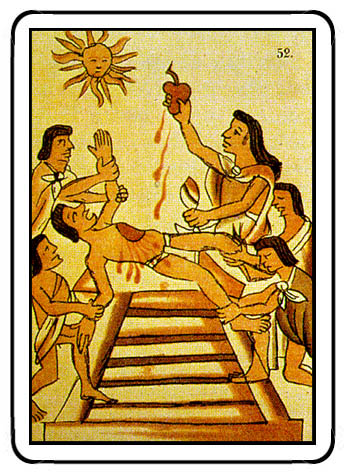I am a big fan of Oaxacan Woodcarving. Good thing I’m going to Oaxaca! Last year, I picked out a fabulous rabbit painted by Aurora Sosa of San Martin Tilcajete. I think I ended up having my husband buy it for me for Christmas or my birthday or something. It looks like the bunny on the left, only in the crouching position.
year, I picked out a fabulous rabbit painted by Aurora Sosa of San Martin Tilcajete. I think I ended up having my husband buy it for me for Christmas or my birthday or something. It looks like the bunny on the left, only in the crouching position.
Over the years, I have purchased a couple of woodcarvings, but they are smaller and less detailed. This was the first one I purchased as a collector – I just thought it was beautiful and I wanted it. If I am lucky, maybe I will get to go to Aurora Sosa’s village and meet her. Her father, Luis Sosa Calvo, is also a carver.
From Wikipedia: Alebrijes originated in Mexico City in the 20th century. The creation of the first alebrijes, as well as the name itself, is attributed to Pedro Linares, a Mixe Indian artisan from Arrazola, Oaxaca who made a living in Mexico City making piñatas, carnival masks and “Judas” figures from papier-mâché. He sold these in markets in Mexico City in the 1930s.
When he was around thirty years old, Linares fell ill with a high fever which caused him to hallucinate. He dreamed that he was in a forest with rocks and clouds, many of which turned into wild, unnaturally colored creatures, some with wings, horns, tails, fierce teeth and bulgy eyes. While seeing the creatures, he heard a crowd of voices which repeated a nonsensical word that sounded like “alebrije.” After he recovered, he began to create the creatures he saw using papier-mâché and cardboard.
The descendents of Pedro Linares, many of whom live in Mexico City near the Sonora Market, carry on the tradition of making alebrijes and other figures from cardboard and papier-mâché. Recently, there has been a yearly Parade of Alebrijes in Mexico City.
Here are some links about paper mache alebrijes and Pedro Linares:
History of Mexican Paper Mache Sculptures
Wild Dreams and Rainbow Faces – article about the Linares family on Novica.com
Pedro Linares family website – has some glitches, but recounts Linares’ original “alebrije” dream.
Paper Mache Dragon by Joel Garcia Grande, who studied with Pedro Linares
The Skeleton at the Feast: The Day of the Dead in Mexico by Elizabeth Carmichael and Chloë Sayer – includes work of the Linares family
Exhibit in San Diego featuring Linares
More from Wikipedia on Wooden alebrijes (paraphrased): “What are called “alebrijes” in Oaxaca is a marriage of native woodcarving traditions and influence from Pedro Linares’ work in Mexico City. Pedro Linares was originally from Oaxaca, and during family visits to Arrazola, he demonstrated the designs he was making in Mexico City. The first to copy the fantastic forms and bright colors was Manuel Jiménez, who carved the figures in local copal wood rather than using paper.
The first to copy the fantastic forms and bright colors was Manuel Jiménez, who carved the figures in local copal wood rather than using paper.
Animal figures had always been carved in the central valleys area of Oaxaca by the Zapotecs since the pre-Hispanic period. Totems of local animals were carved for luck or religious purposes as well as hunting decoys. Figures were also carved for children as toys, a tradition that continued well into the 20th century. After the craft became popular in Arrazola, it spread to Tilcajete and from there to a number of other communities.
Now the three main communities are San Antonino Arrazola, San Martin Tilcajete and La Union Tejalapam, each of which has developed its own style. The carving of wood figures did not have a name, so the name “alebrije” eventually became adopted for any carved, brightly colored figure of copal wood, whether it is of a real animal or not. To make the distinction, the carvings of fantastic creatures, closer to Linares’ alebrijes, are now sometimes called “marcianos” (martians).
Oaxacan alebrijes have eclipsed the Mexico City version, with a large number of stores in and around the city of Oaxaca selling the pieces and it is estimated that more than 150 families in the area make a living carving and painting the figures. Many rural households in the Mexican state of Oaxaca have prospered over the past three decades through the sale of these brightly painted, whimsical wood carvings. They sell them to international tourists and the ow ners of ethnic arts shops in the United States, Canada, and Europe.
ners of ethnic arts shops in the United States, Canada, and Europe.
Here are some books I found about Oaxacan Woodcarving:
Mexican Folk Art: From Oaxacan Artist Families by Arden Aibel Rothstein and Anya Leah Rothstein
Crafting Tradition: The Making and Marketing of Oaxacan Wood Carvings by Michael Chibnik
Oaxacan Woodcarving: The Magic in the Trees by Shepard Barbash and Vicki Ragan and the sequel: Changing Dreams: A Generation of Oaxaca’s Woodcarvers
Dream Carver by Diana Cohn and illustrated by Amy Cordova – children’s book inspired by the story of Manuel Jimenez
Becoming Naomi Leon by Pam Munoz Ryan – the focus is on the Night of the Radishes, but Naomi is descended from a Oaxacan woodcarving family.
ABeCedarios: Mexican Folk Art ABCs in English and Spanish by Cynthia Weill. The carvings were made by Moisés Jiménez and Armando Jiménez and photographed by K.B. Basseches. Cynthia Weill also wrote Opuestos: Mexican Folk Art Opposites in English and Spanish with carvings by Martín Santiago and Quirino Santiago. She also has a new book coming out called Colores de la Vida: Mexican Folk Art Colors in English and Spanish (First Concepts in Mexican Folk Art) – there is no mention of who the carvers are.
Lesson Plans:
Wood Animalitos: alebrijes made from pieces of wood
Woodsies Extraordinaire – could be adapted to Oaxacan Wood Animals
Texture Critters – a drawing project inspired by Oaxacan art
Mythical Beasts – can be adapted – students create a mythical beast and write a story about it
Mexican Animalitos – these are made from paper mache
Whimsical Oaxacan Animals – made from paper clay
Alebrije Painting Lesson based on a book based on a Zapotec legend called Rabbit and Coyote by Tony Johnston and illustrated by Tomie dePaola
Drawing Oaxacan Alebrijes – from Crayola.com
Here is a 9 week art unit on Mexico for sixth grade
Here is a lesson plan where students construct a fantasy animal of paper and plaster (for 3rd or 4th grade)
Alebrijes: Fantasy Animals – 3rd grade Spanish animal unit with links to Activity Sheets in English and Spanish – very well thought out.
Websites with examples of Oaxacan Woodcarvings:
El Caracol Zapoteca – beautiful photographs – my favorite!
La Fuente Imports – photos also very well done
Solmar Imports – more examples, along with other folk art
Port Wahakaa’s website, The Art of Oaxacan Woodcarving has an excellent gallery with articles on copal trees, the styles of woodcarving villages, animals in myth and nature. There are three galleries illustrating the work of many carvers, with short comments on each artist. There is also a “Rough Guide” describing various styles with an examples from the same artists described in the gallery.
Articles about Artists and the art of woodcarving:
Here is an article on Gabino Reyes and Eloy Santiago
Crizmac Article on Zeny Fuentes
Website of Jacobo and Maria Angeles Ojeda – own a gallery and restaurant in Tilcajete
MexOnline.com article on how woodcarvings are made
Oaxacan Woodcarving: Innovation Meets Tradition – this is a DVD featuring Zeny Fuentes offered by CrizmacEl Caracol Zapoteca offers articles on woodcarving and artists
From StudySpanish.com – here is a reading in English and Spanish about alebrijes, with a recording of the Spanish reading – there is also a long version for more advanced students.
Finally, here is a clipping I got a while back from the Crizmac website (click on the image for full size).
















